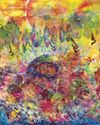Kaya York experiences monism, mysticism, and Schopenhauerian ethics while playing David OReilly’s video game.
It’s normal to begin discussions about particularly interesting, beautiful, or profound video games by noting with surprise that such games even exist. They do. There are more games like these than one might suppose, such as Dear Esther, which has the player simply wander around an island and listen to fragments of a letter, and That Dragon Cancer, an autobiographical game about the loss of a child. However, it would be just as well to begin discussing David OReilly’s new game, Everything, by referring to a different canon – that of Borges, Camus, and Voltaire. Like these writers, OReilly and his team have created a work of art that’s structured around a philosophical idea. The difference is that Everything allows its player to encounter this idea through experience rather than through reading a narrative.
In the game the player begins as an animal, communicating with other creatures and objects. The player can then leave the body of the animal and become the other things he or she encounters: a tree, a building, a streetlight. This carries through to the micro and macro scales: one can become anything from a jellybean, grain of sand, or a microscopic particle, to a planet or a galaxy! (I can imagine a sequel where you can play as parts of things: the vein of a tree, or a wrinkle in fabric.) Although one is forced to experience being one thing at a time, the player’s avatar can ultimately be all of these things.
I would like to take a moment to consider this word ‘avatar’. One of the conventions of gaming is that an ‘avatar’ is the entity that one plays as in a game. The term comes from the Sanskrit avatarana, which refers to the incarnation of a deity in earthly form. In the 1800s in the West, the term ‘avatar’ also came to refer to the concrete manifestation of something abstract.
Diese Geschichte stammt aus der August/September 2017-Ausgabe von Philosophy Now.
Starten Sie Ihre 7-tägige kostenlose Testversion von Magzter GOLD, um auf Tausende kuratierte Premium-Storys sowie über 8.000 Zeitschriften und Zeitungen zuzugreifen.
Bereits Abonnent ? Anmelden
Diese Geschichte stammt aus der August/September 2017-Ausgabe von Philosophy Now.
Starten Sie Ihre 7-tägige kostenlose Testversion von Magzter GOLD, um auf Tausende kuratierte Premium-Storys sowie über 8.000 Zeitschriften und Zeitungen zuzugreifen.
Bereits Abonnent? Anmelden

Metaphors & Creativity
Ignacio Gonzalez-Martinez has a flash of inspiration about the role metaphors play in creative thought.

Medieval Islam & the Nature of God
Musa Mumtaz meditates on two maverick medieval Muslim metaphysicians.

Robert Stern
talks with AmirAli Maleki about philosophy in general, and Kant and Hegel in particular.

Volney (1757-1820)
John P. Irish travels the path of a revolutionary mind.

IT'S A WONDERFUL LIFE
Becky Lee Meadows considers questions of guilt, innocence, and despair in this classic Christmas movie.

"I refute it thus"
Raymond Tallis kicks immaterialism into touch.

Cave Girl Principles
Larry Chan takes us back to the dawn of thought.

A God of Limited Power
Philip Goff grasps hold of the problem of evil and comes up with a novel solution.

A Critique of Pure Atheism
Andrew Likoudis questions the basis of some popular atheist arguments.

Exploring Atheism
Amrit Pathak gives us a run-down of the foundations of modern atheism.